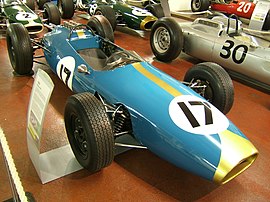Brabham BT3
 |
|||||||||
| Category | Formula One | ||||||||
|---|---|---|---|---|---|---|---|---|---|
| Constructor | Motor Racing Developments | ||||||||
| Designer(s) | Ron Tauranac | ||||||||
| Successor | Brabham BT7 | ||||||||
| Technical specifications | |||||||||
| Chassis | Steel spaceframe | ||||||||
| Engine | Coventry Climax FWMV, 1,494 cc (91.2 cu in), 90° V8, naturally aspirated, mid-engine, longitudinally mounted | ||||||||
| Transmission | Francis-Colotti Type-34, 6 speed manual | ||||||||
| Weight | 1,105 lb (501.2 kg) | ||||||||
| Tyres | Dunlop | ||||||||
| Competition history | |||||||||
| Notable entrants | Brabham Racing Organisation | ||||||||
| Notable drivers |
|
||||||||
| Debut | 1962 German Grand Prix | ||||||||
|
|||||||||
| Constructors' Championships | 0 | ||||||||
| Drivers' Championships | 0 | ||||||||
| n.b. Unless otherwise stated, all data refer to Formula One World Championship Grands Prix only. |
|||||||||
The Brabham BT3 is a Formula One racing car. It was the first Formula One design to be produced by Motor Racing Developments for the Brabham Racing Organisation, and debuted at the 1962 German Grand Prix. The Brabham BT3 was the vehicle with which team owner – then two-time World Champion – Jack Brabham, became the first driver ever to score World Championship points in a car bearing his own name, at the 1962 United States Grand Prix. The following year Brabham also became the first driver ever to win a Formula One race at the wheel of an eponymous car, again driving the BT3, at the 1963 Solitude Grand Prix. The BT3 design was modified only slightly to form the Tasman Series-specification Brabham BT4 cars.
The BT3's design followed on from Motor Racing Developments' two previous Formula Junior cars. Although the monocoque-chassied Lotus 25 had been introduced by Team Lotus earlier in the 1962 season, designer Ron Tauranac erred on the side of strength and safety in the BT3's design and kept to established Formula One practice in almost all technical specifications. Tauranac based the car around an exceptionally stiff, steel-tubed spaceframe chassis, which he reasoned would be easier to repair than a monocoque, and was closer to what MRD were selling to customers at the time. Also in contrast to Lotus practice were the BT3's internal dimensions, which provided a comparatively comfortable and spacious driving environment for the pilot, with oil and water cooling pipes run outside the cockpit to keep heat to a bearable level. The chassis was clothed in a fibreglass body shell, which was painted in a bright turquoise shade with a metallic gold stripe running down the centre.
...
Wikipedia
